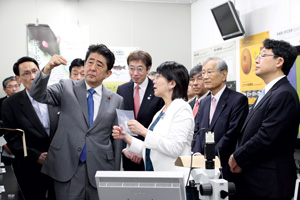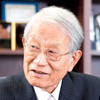Jun. 22, 2018 Perspectives Other
Engaging society, changing society
As RIKEN embarks on its new 7-year plan, President Matsumoto discusses his vision for ensuring that research engages society and contributes to sustainable development.
 As RIKEN embarks on its new seven-year plan, President Hiroshi Matsumoto discusses his vision for ensuring that research engages society and contributes to sustainable development. © 2018 RIKEN
As RIKEN embarks on its new seven-year plan, President Hiroshi Matsumoto discusses his vision for ensuring that research engages society and contributes to sustainable development. © 2018 RIKEN
When Prime Minister Shinzo Abe introduced the Japanese Government’s Fifth Science and Technology Basic Plan early in 2017, he outlined his thoughts on what he calls Society 5.0, or the ‘super-smart society’. He predicted that Society 5.0 will be a fifth step in an evolution away from the industrial and information societies, at the culmination of which “all things are connected and all technologies fuse”. We will address the rapidly changing landscape of science and technology as RIKEN enters its next seven-year phase, which was outlined in April 2018 as part of our fourth mid- to long-term plan.
RIKEN’s reforms under the new plan address three specific agendas: to help raise the overall standard of science and technology in Japan; to act as a catalyst for innovation through research; and to provide greater stability to RIKEN’s personnel by offering more indefinite-term employment contracts. These changes also tie into adjustments linked to RIKEN’s move from an Independent Administrative Institution to a Designated National Research and Development Institute in 2016, which came with the promise of more flexibility in funding and an increased responsibility to initiate new high-level research systems.
Staying at the cutting edge
As part of the new plan, I have called for the introduction of three innovation designers — appointees who will specialize in identifying real-world problems and communicating those needs to researchers, not only from a scientific perspective but also from the viewpoints of the social sciences and humanities. One of these designers is a team leader from RIKEN who has a keen interest in development of artificial intelligence and its impact on society, while the other two have been brought in from outside of RIKEN, moving from private consultancies into positions where they can influence the long-term vision of the organization. This shift toward more contact with the social sciences is particularly important to us: RIKEN researchers are not permitted to purely pursue social science research, but this does not preclude research related to the intersection between the natural and social sciences. Exploring the ‘missing area’ between the two is important to help engage with society and to drive future breakthroughs, and so I wish to encourage young scientists to tackle issues from many angles.
As part of the drive to ensure that the basic research we carry out is at the science’s forefront, we have also established a new organization—the Cluster for Pioneering Research—which is tasked with encouraging scientists to become pioneers in new scientific fields and to build upon RIKEN’s unique capabilities for interdisciplinary research.
Another new aspect of our strategy to strengthen RIKEN’s basic research and to promote interdisciplinary collaboration has been the reorganization of our bioscience-related centers. From April 2018, RIKEN’s six bioscience centers have been reorganized into four: the BioResource Research Center, the Center for Brain Science, the Center for Biosystems Dynamics Research, and the Center for Integrative Medical Sciences.
RIKEN recently launched a new engineering network. Early on, RIKEN was focused on engineering, and Japan’s postwar recovery was underpinned by this emphasis in many of the country’s leading universities and institutes. However, I think that the engineering mindset has been lost in subsequent years, and researchers have forgotten the importance of ‘daily science’—science with real-world impact. I have thus called for a new framework that will identify the seeds for innovation and foster new engineering network initiatives. This will include interdepartmental collaborations as well as partnerships with industry.
Japan’s hub for science and technology
 Prime Minister Shinzo Abe (front left) visited the former RIKEN Center for Developmental Biology (CDB) in 2017. Masayo Takahashi (front right) of the Laboratory for Retinal Regeneration, whose work led to a world first clinical trial that used induced pluripotent stem (iPS) cells in humans, explains developments in her recent research. © 2018 RIKEN
Prime Minister Shinzo Abe (front left) visited the former RIKEN Center for Developmental Biology (CDB) in 2017. Masayo Takahashi (front right) of the Laboratory for Retinal Regeneration, whose work led to a world first clinical trial that used induced pluripotent stem (iPS) cells in humans, explains developments in her recent research. © 2018 RIKEN
These reforms complement ongoing, Japan-wide measures to build a stronger research ecosystem, within which RIKEN will act as one of the country’s premier research hubs.
RIKEN has earned this role, remaining Japan’s top institution for highly cited research. Of the approximately 2,400 papers produced by our scientists each year, 5.6 per cent are in the top 1 per cent of papers cited in their field, a number head-and-shoulders above figures at other Japanese research institutions.
As a result of our efforts to strengthen global collaborations, the use of RIKEN’s large-scale technical research facilities has also been increasing in recent years, including the RI Beam Factory, SPring-8 and the K computer, which are all available for shared use by researchers from around the world. The intent is to parlay these research strengths to position RIKEN as a hub for the most innovative research and academia–industry collaborations with a global outlook and strong input from other international bodies. To facilitate this, we have established a new organization, the Cluster for Science, Technology, and Innovation Hub, which will expedite collaborative research with both academia and industry.
Progressing in parallel are plans to form a subsidiary company that will be responsible for managing all of RIKEN’s intellectual property. Preparations are now underway to develop a platform for discussing new directions in scientific research, the best use of existing resources and support for new ventures. The aim is for this company to yield a return of US$100 million in 10 years, based on $80 million in joint-research funding and $20 million in patent income.
Giving researchers the chance to take a long-term view
Starting in April, a new, longer-term vision for projects has been extended to staffing. By 2025, we plan to increase the proportion of indefinite-term employees to 40 per cent, a huge jump from the current 10 per cent. This change has been much discussed, since the previous system, in which the vast majority of researchers were on fixed-term contracts (renewed every three to five years), may have prevented researchers from exploring a particular subject in-depth or seeing projects through to fruition. It may also have created instability and deterred applications from international researchers.
The Hakubi program
Finally, the new Hakubi program is an initiative that brings together many of the ideas I have mentioned. It will give young researchers the chance to pursue their own projects in their own labs. This program is also designed to encourage original thinking and bridge the divide between the sciences and humanities in order to tackle society's future challenges: for example, artificial intelligence researchers are developing robotics and computer-based intelligence, so there is a need to integrate ethical and philosophical viewpoints into research so that it is meaningful to society. This emphasis ties in with our focus on interdisciplinary collaboration elsewhere.
Building on our unique strengths
Although there is, of course, a need for reform to move forward, there has been much to be proud of in the three years since I assumed my post. Not the least of which was the naming of a new element after RIKEN scientists were the first to successfully synthesize element 113, the first addition to the periodic table in many years. This achievement, which was brought about through research projects with long-term perspectives and goals, saw the element named nihonium (after Japan) in November 2016. We are continuing our search for new elements, starting with 119 and moving on from there. But as Prime Minister Abe suggested last year, it is also critical to recognize the trends that will shape Society 5.0, including the rise of artificial intelligence, big data, the Internet of Things and sustainability science. While the name for this set of changes differs from country to country—in Germany and in other places it is sometimes called Industry 4.0—when people talk of a post-digital society, there are universal themes that impact all sectors, including government, industry, academia and average citizens.
Fortunately, as a Designated National Research and Development Institute, RIKEN has some unique strengths upon which it can build to do this. Our research units tend to be much larger than those of counterparts at Japanese universities. The research environment also promotes interdisciplinary exchange and a free flow of opinions. Academic scientists and those from industry are treated on equal terms. Moreover, owing to our independent status, the institute has been able to launch large-scale national projects such as the SPring-8 and the BioResource Research Center, enabling researchers to engage in ‘big science’—high-investment, large-scale projects with equally big implications for research outcomes.
Ever since joining RIKEN in 2015, I have felt that RIKEN’s long-term standing internationally and its importance to Japan’s research environment could not be underestimated, and my goal has been to continue to strengthen it, so that we can truly lead the world. It is vital to our shared futures that we remain at the forefront and be the drivers of social change.
References
About the Researcher
Hiroshi Matsumoto, RIKEN President

Hiroshi Matsumoto has been president of RIKEN since 2015. He has a doctorate in engineering. Much of his work centered on plasma in the geomagnetosphere and cosmosphere. He is an Honorary Officer of the Most Excellent Order of the British Empire (OBE) and a Chevalier in the French Legion of Honor and has twice been part of group efforts recognized with NASA Group Achievement Awards.
